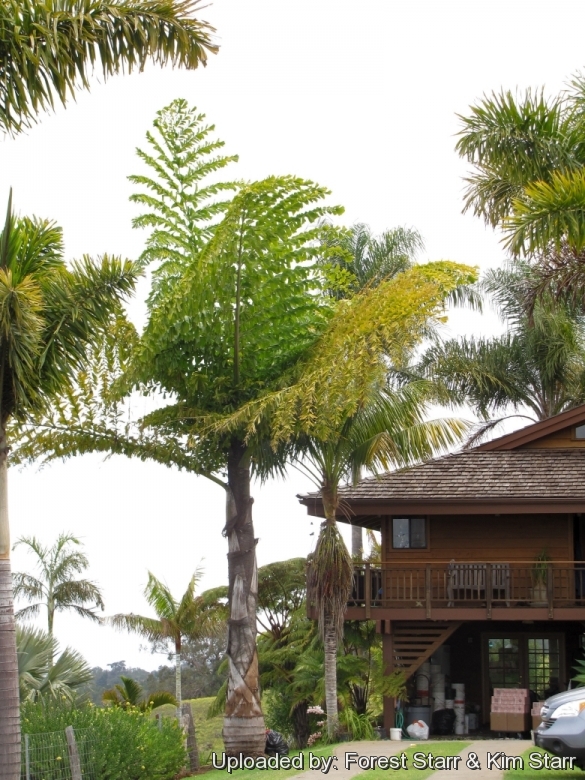Accepted Scientific Name: Caryota no Becc.
Nuovo Giorn. Bot. Ital. 3: 12 1871

Caryota rumphiana var. borneensis (Caryota no) Photo by: Forest Starr & Kim Starr
Habit at Kula, Maui, Hawaii (USA). April 03, 2012.
Origin and Habitat: Borneo, Indonesia (Kalimantan); Malaysia (Sabah, Sarawak)
Habitat: Rainforest.
Synonyms:
Common Names include:
ENGLISH: Giant fishtail palm, Borneo fishtail palm
Description: This is one of the larger and fast growing species of Caryota often confused with Caryota gigas, but having a bit less spread than one. It has a thick solitary trunk, and huge intricate leaves that make this palm totally compelling. The Caryota palm is monocarpic that is to say it dies, after bearing fruit.
Trunk: Solitary, brownish grey. Height: To 20 m.
Crown: Spread: To 10 m.
Leaves: Pinnately compound, alternately opposed, bipinnate, to 5 m long, light green.
Inflorescence: Large mop like emerging from crown.
Flower: Golden in colour.
Fruit: Dark Purple/Black.
Seeds: Round, dark brown, glossy, approximately, 1,7 centimetres across.
Special note: The Caryota genus, is the only palm that is bipinnate.
Bibliography: Major references
1) Forest & Kim Starr Caryota no (Giant fishtail palm). Plants of Hawaii. <http://www.starrenvironmental.com>. Downloaded on 21 August 2014.
2) Don Ellison, Anthony Ellison “Cultivated Palms Of The World” UNSW Press, 01/May/2001
3) Robert Lee Riffle, Paul Craft “An Encyclopedia of Cultivated Palms” Timber Press, Portland 2007
4) John Dransfield, Natalie W. Uhl, Conny B. Asmussen, William J. Baker, Madeline M. Harley, Carl E. Lewis: “Genera Palmarum. The Evolution and Classification of Palms.” Royal Botanic Gardens, Kew 2008
5) David Jones: “Palmen” Könemann, Köln, 2000
 Fronds at Kula, Maui, Hawaii (USA). April 03, 2012. (Caryota no) Photo by: Forest Starr & Kim Starr
Fronds at Kula, Maui, Hawaii (USA). April 03, 2012. (Caryota no) Photo by: Forest Starr & Kim StarrSend a photo of this plant.The gallery now contains thousands of pictures, however it is possible to do even more. We are, of course, seeking photos of species not yet shown in the gallery but not only that, we are also looking for better pictures than those already present.
Read More... Cultivation and Propagation: It is an easy to grow palm that likes rich loamy soil, but is adaptable to clay and sand both slightly alkaline and acidic. Good drainage is also important. It is a fast grower, but it can grow extremely fast given the right conditions of warmth and humidity, together with a rich soil and an abundance of water. Caryota noSN|24278]]SN|24278]] vary in shape. Specimens raised in dry and/or infertile soils tend to be smaller in stature with smaller leaves. Light also affects the plant's form while those grown in full sun are more compact.
Fertilization: Need a perfect fertilizer diet including all micro nutrients and trace elements or slow release fertilizer. Micronutrient deficiencies are occasional problems. If it doesn't get enough Mn and Fe, the leaves take on a rather unhealthy yellow colour. Micronutrient deficiencies only show up on soil with a high pH.
Water Requirements: Needs consistently moist soil, do not let dry out between waterings. however it does not want to sit in continually wet, mucky soil. The roots and lower trunk can rot if soil is kept too moist.
Light: Filtered light when young, full sun when mature.
Hardiness: This is probably the most cold tender of all the larger Caryotas and grows well only in the perfect microclimates of USDA zone 10b, young plants are even more cold sensitive; it is widely cultivated in tropical regions.
Maintenance: Prune diseased, damaged or drying fronds, but do not prune if the frond still has some green colour. Palms recycle nutrients from dead or dying fronds and use them for healthier fronds. Palms only have a set number of new leaves that can sprout and grow per year and removing fronds will not increase that number. If you cut off more than what will grow annually, you could be left with a pretty bare and bald palm.
Roots: Not a problem.
Propagation: Fresh seeds germinate in 4 months to 1 year to germinate in warm media and the seedlings are attractive.
Uses: Either as a single specimen or in groups, this is a strikingly beautiful species. Its very neat appearance and stature makes it perfect near highways and used to accent residential landscapes. Culture in containers is possible although growth rates are slower. A bright patio will provide an excellent environment for young specimens which can eventually be planted in a sunny location.
Warning: Flesh of seed and trunk is caustic to touch and should be handled with care and also Caryotas are prone to falling over in high winds while still alive, so careful where you plant this palm.










